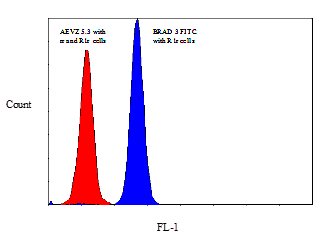IntroductionDetectionandquantificationoffetalredbloodcells(RBCs)inmaternalbloodsamplesisessentialforobstetricalmanagement.MeasurementoffetalRBCsiscriticalastheextentofFetomaternalHemorrhage(FMH),thetransplacentalpassageoffetalRBCsintothematernalcirculation,hasconsequencesforfurthertreatmentofmotherandchild.
FrequencyandsizeofFMHisdirectlyinfluencedbycomplicationsinaBDominaltrauma,sUSPectedplacentalinjuryorafteracaesareansection.SevereFMHmayleadtointra-uterinedeath.IncaseofantigenincompatibilitybetweenmotherandchildFMHmayresultinrespiratoryproblemsoranaemia,likeHaemolyticDiseaseoftheNewborn.
Thedetection(andthusenumeration)offetalredbloodcells(fRBCs)isusedtocalculatetheextentofFMH,eitherincaseoftraumawithsuspectedplacentalinjuryorinthesituationofaRhDincompatibilitybetweenthefetusandthemother.TheamountoffRBCsisameasureforthepreventionofhemolyticdiseaseofthenewbornusing(prophylactic)anti-Dtherapy.
PrincipleoftheFMHKit
Byflowcytometry,BRAD3FITCcanbeusedtoaccuratelyquantitatethenumberofRhDpositivecellsinamixtureofRhDpositiveandnegativecells.ThereforeFMHcanbeanalyzedinamaternalbloodsamplewhenanegativewomancarriesaRhDpositivefetus.
Foroptimalinterpretationoftheresultsthekitcontainsananti-RhDantibody(BRAD3)andanegativecontrolantibody(AEVZ5.3)bothlabeledwithFITC.

Figure:ThefigureshowstheresultsofBRAD3FITCandAEVZ5.3FITC.TheredhistogramisAEVZ5.3withnegativecells.ThebluehistogramisBRAD3FITCwithRhDpositivecells.
ConclusionTheFMHKitcanbeusedonlyincaseofRhincompatibilitybetweenmotherandchild.ForallothercasestheFetalCellCount™Kitarerecommended.













